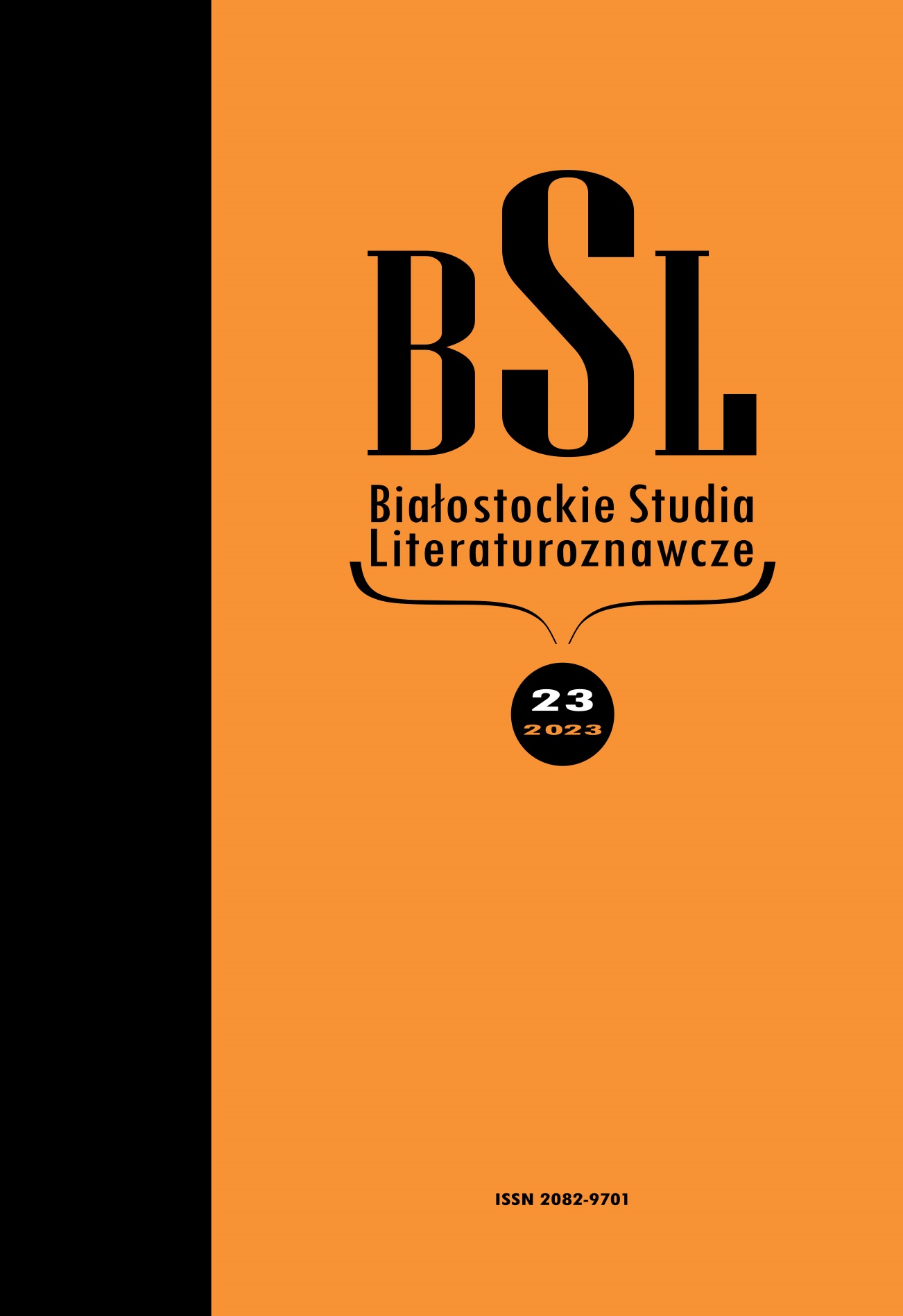Other worlds? Landscapes and Spacescapes in The Planets (2019)
Magdalena Kempna-Pieniążek
Institut of Culture Studies. University of Silesia in Katowicehttps://orcid.org/0000-0002-2569-5596
Abstract
The author of the article looks at the particular relationship between terrestrial landscapes and spacescapes, understood as a kind of cultural landscape, in the BBC series The Planets (2019). The landscape strategies employed by the series’ creators are examined in the context of cinematic landscape theory and selected strands of astroculture studies. The author sees The Planets as an example of the effective use of terrestrial landscapes in the process of symbolic terraforming of selected Solar System objects. The main arguments in favour of this thesis are the three distinctive strategies present in the series: the construction of vertical landscapes, the juxtaposition of natural earthly landscapes with computer-generated cosmic images, and the mobilisation of an aesthetic of the sublime with its anthropocentric background.
Keywords:
space documentary, spacescapes, BBC – popular science series, sublimity, cultural landscapeReferences
Boczkowska Kornelia (2017), The Homely Sublime in Space Science Documentary Film: Domesticating the Feeling of Homelessness in Carl Sagan’s „Cosmos” and Its Sequel, „Kultura Popularna”, nr 4, s. 24–34.
Bradbury Ray (1986), Luty 2003. Przerwa, w: R. Brandbury, Kroniki marsjańskie, przeł. A. Kaska, Warszawa: Iskry, s. 85.
Conley Tom (2007), Cartographic Cinema, Minneapolis – London: University of Minnesota Press.
Copik Ilona (2017), Topografie i krajobrazy. Filmowy Śląsk, Katowice: Wydawnictwo Uniwersytetu Śląskiego.
Cox Brian, Cohen Andrew (2018), Ukryte siły natury, przeł. R. Kosarzycki, Kraków: Copernicus Centrer Press.
Cox Brian, Cohen Andrew (2024), Człowiek i wszechświat, przeł. L. Lamża, Kraków: Copernicus Center Press.
Dickens Peter, Ormrod James S. (2007), Cosmic Society. Towards a sociology of the universe, London–New York: Routledge.
Dunnett Oliver (2023), The Spaces of Outer Space, w: The Routledge Handbook of Social Studies of Outer Space, red. J.F. Salazar, A. Gorman, London–New York: Routledge, s. 84–95.
Frydryczak Beata (2013), Krajobraz. Od estetyki the picturesque do doświadczenia topograficznego, Poznań: Wydawnictwo Poznańskiego Towarzystwa Przyjaciół Nauk.
Frydryczak Beata (2014), O dwóch sensach krajobrazu, w: Krajobraz kulturowy, red. B. Frydryczak, M. Ciesielski, Poznań:Wydawnictwo Poznańskiego Towarzystwa Przyjaciół Nauk, s. 15–41.
Frydryczak Beata, Angutek Dorota (2014), Od krajobrazu naturalnego do krajobrazu kulturowego. Wprowadzenie, w: Krajobrazy. Antologia tekstów, red. B. Frydryczak, D. Angutek, Poznań: Wydawnictwo Poznańskiego Towarzystwa Przyjaciół Nauk, s. 7–19.
Geppert Alexander C.T. (2012), European Astrofuturism, Cosmic Provincialism: Historicizing the Space Age, w: Imagining Outer Space. European Astroculture in the Twentieth Century, red. A.C.T. Geppert, New York: Palgrave Mcmillan, s. 4–24.
Gorman Alice (2005), The Cultural Landscape of Interplanetary Space, „Journal of Social Archaeology”, vol. 5, no 1, s. 85–107.
Jefries Michael (2003), BBC Natural History versus Science Paradigms, „Science as Culture”, t. 12, nr 4, s. 528–543.
Kessler Elizabeth A. (2012), Picturing the Cosmos. Hubble Space Telescope Images and the Astronomical Sublime, Minneapolis – London: University of Minnesota Press.
Kita Barbara (2016), Pejzaż refleksyjny, w: Przestrzeń w kulturze współczesnej, red. D. Mazur, B. Morzyńska-Wrzosek, Bydgoszcz: Wydawnictwo Uniwersytetu Kazimierza Wielkiego, s. 337–347.
Kita Barbara (2017), Pejzaż za oknem. Europejskie widokówki filmowe – wprowadzenie, w: Filmowe pejzaże Europy, red. B. Kita, M. Kempna-Pieniążek, Katowice: Wydawnictwo Uniwersytetu Śląskiego, s. 7–25.
Koch Natalie (2021), Whose Apocalypse? Biosphere 2 and the Spectacle of Settler Science in the Desert, „Geoforum”, nr 124, s. 36–45.
Louson Eleanor (2018), Taking Spectacle Seriously: Wildlife Film and the Legacy of Natural History Display, „Science in Contexts”, no 1, s. 15–38.
Messeri Lisa (2016), Placing Outer Space. An Earthly Ethnography of Other Worlds, Durham–London: Duke Univeristy Press.
Messeri Lisa (2017), Resonant Worlds: Cultivating Proximal Encounters in Planetary Science, „American Ethnologist”, vol. 44, no 1, s. 131–142.
Mirzoeff Nicholas (2016), Jak zobaczyć świat, przeł. Ł. Zaremba. Kraków–Warszawa: Karakter.
Ostrowska Elżbieta (2000), Przestrzeń filmowa, Kraków: Rabid.
Pak Chris (2016), Terraforming: Ecopolitical Transformations and Environmentalism in Science Fiction, Liverpool: Liverpool University Press.
Sage Daniel (2014), How Outer Space Made America. Geography, Organization and the Cosmic Sublime, Furnham–Burlington: Ashgate.
Sugiera Małgorzata (2023), Kolonizacja jako terraformowanie: klątwa Argonautów w epoce antropocenów (ćwiczenia z lektury), „Postscriptum Polonistyczne”, nr 2, s. 1–16.
Topolski Jan (2023), Obce fonosfery. Dźwiękowe krajobrazy pozaziemskich planet w kinie science fiction, „Kwartalnik Filmowy”, nr 122, s. 58–84.
Virilio Paul (2001), Maszyna widzenia, przeł. B. Kita, w: Widzieć, myśleć, być. Technologie mediów, red. A. Gwóźdź, Kraków: Universitas, s. 39–63.
Institut of Culture Studies. University of Silesia in Katowice https://orcid.org/0000-0002-2569-5596
License

This work is licensed under a Creative Commons Attribution-ShareAlike 4.0 International License.
Articles published on the platform of Białostockie Studia Literaturoznawcze are available under the license CC-BY-SA 4.0 (CC Attribution-ShareAlike 4.0).
All interested parties have access to the published articles under the following conditions:
1.They must acknowledge authorship, which means crediting the author, title, source, together with the disseminated work (including the hyperlinks to the original work and doi) as well as the same license under the same conditions.
2. Derivative works can be distributed only under the same license as the original work.
The University of Białystok retains the right to the entire journal (layout, graphic design, title, cover design, logo, etc.).
The author retains the property right but confers on the University of Białystok the right to use the work.



